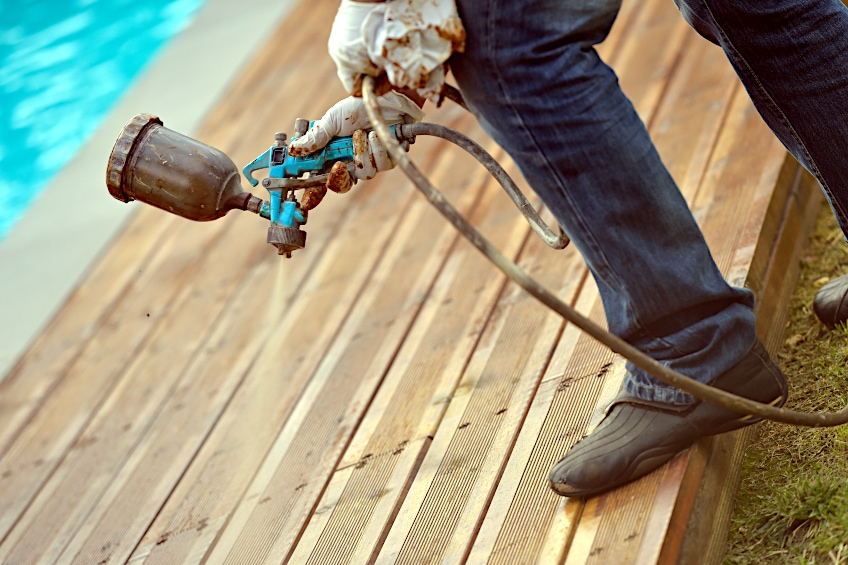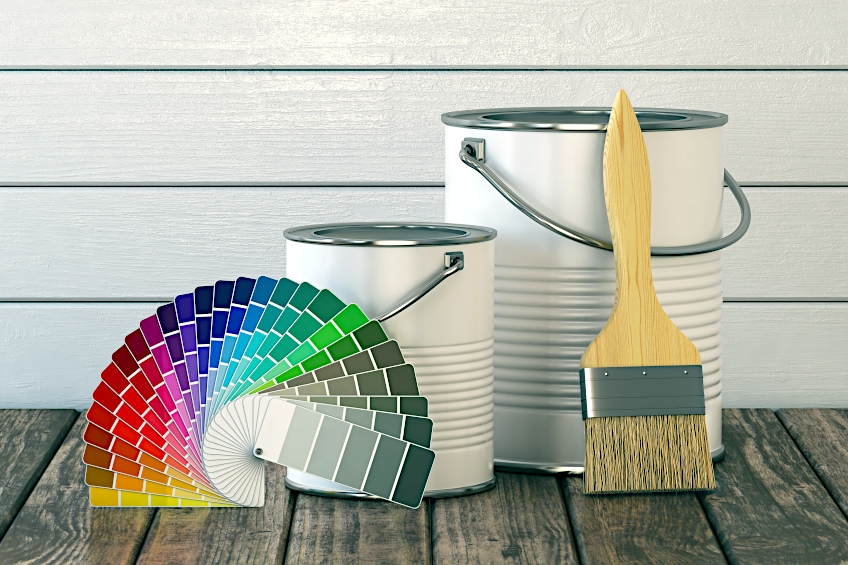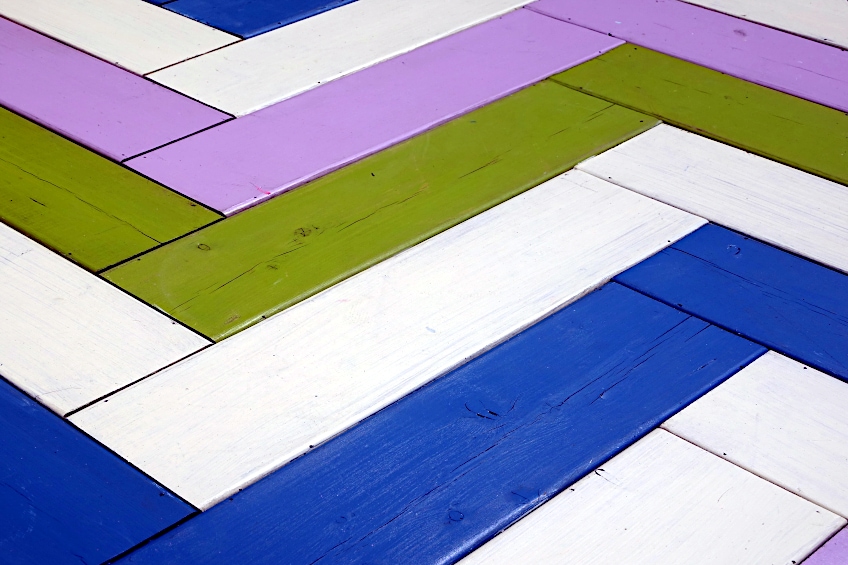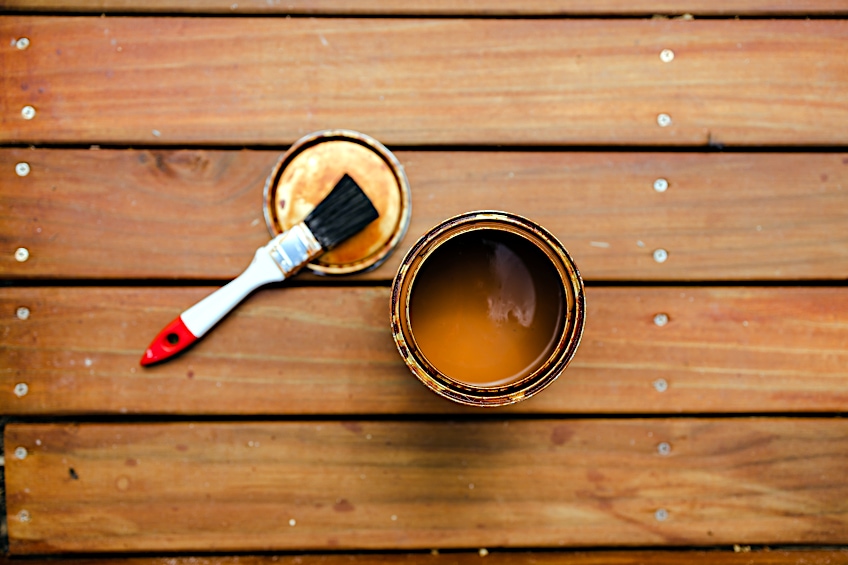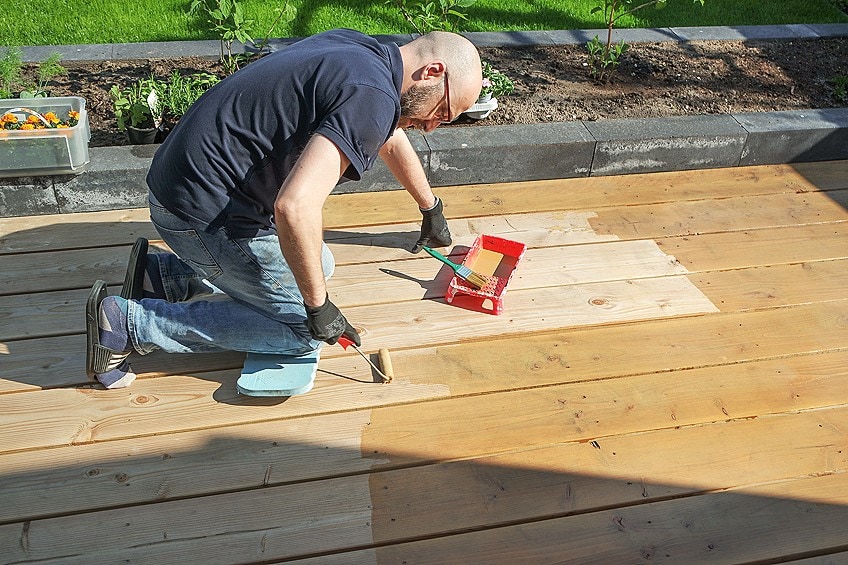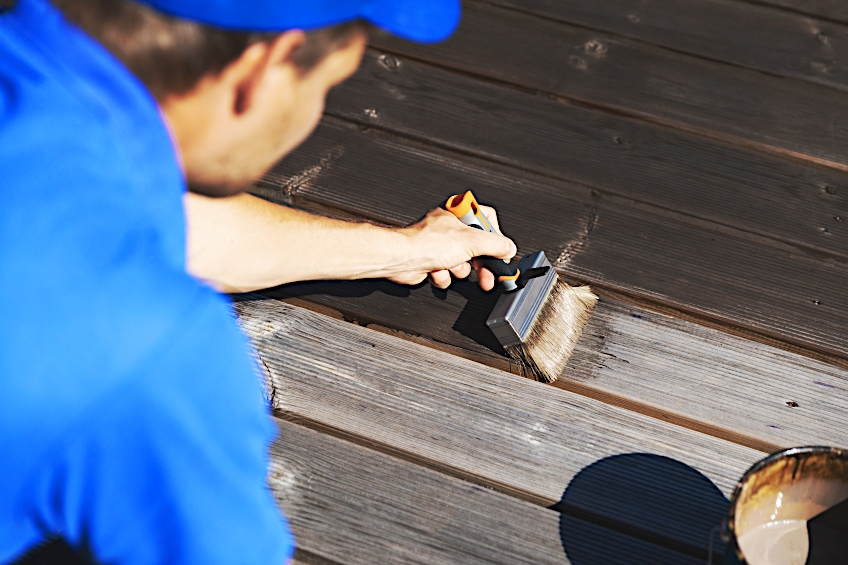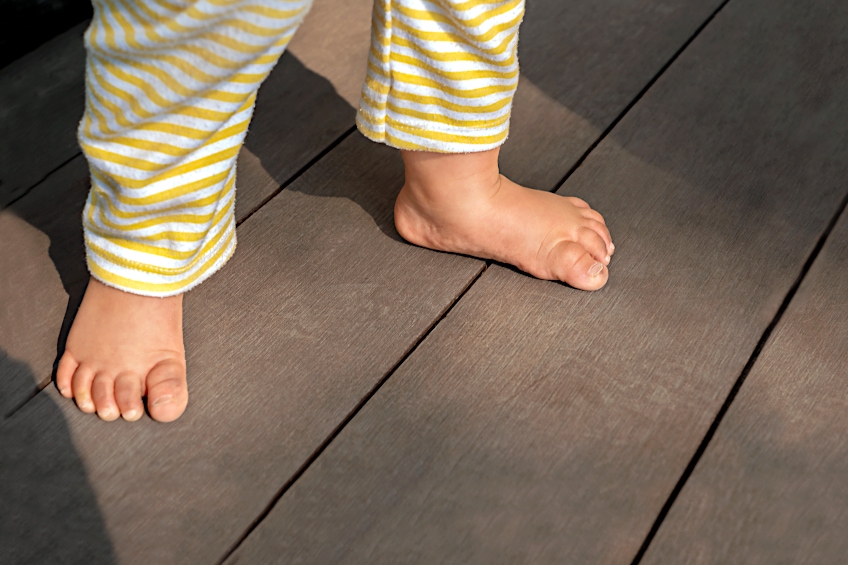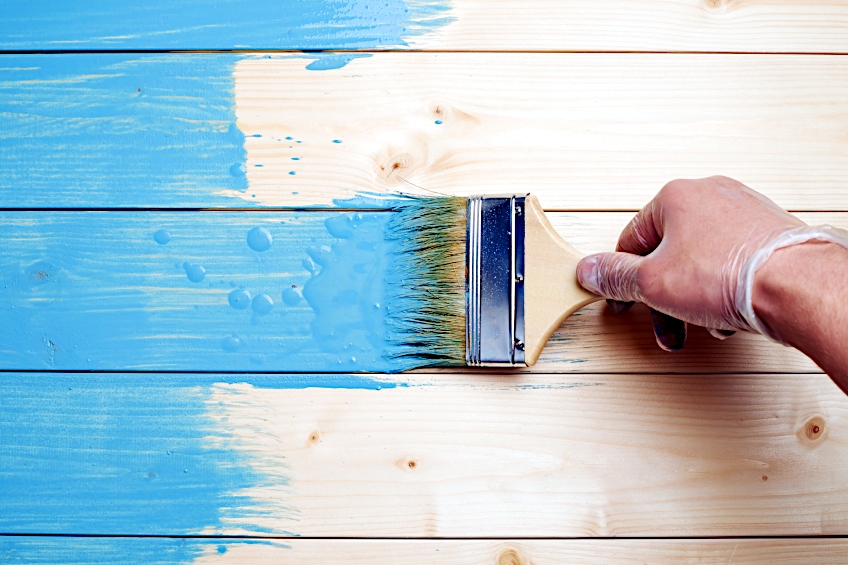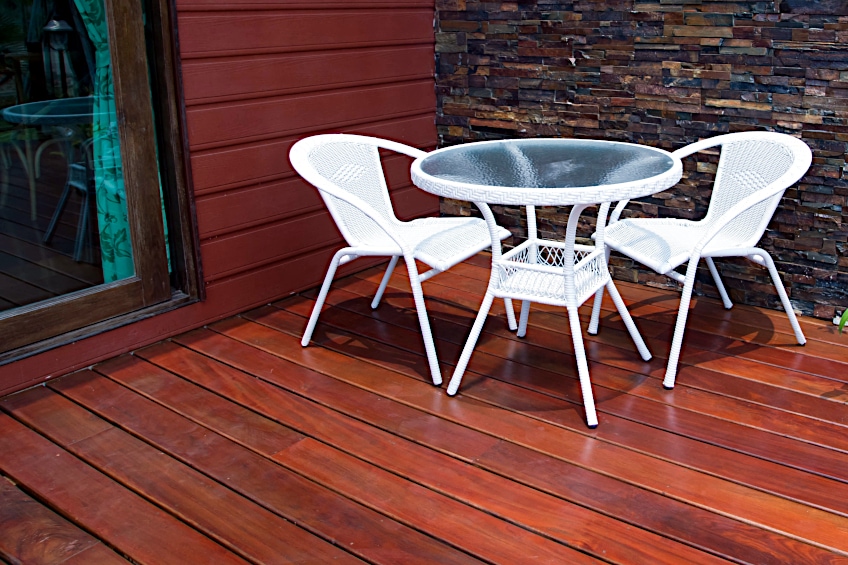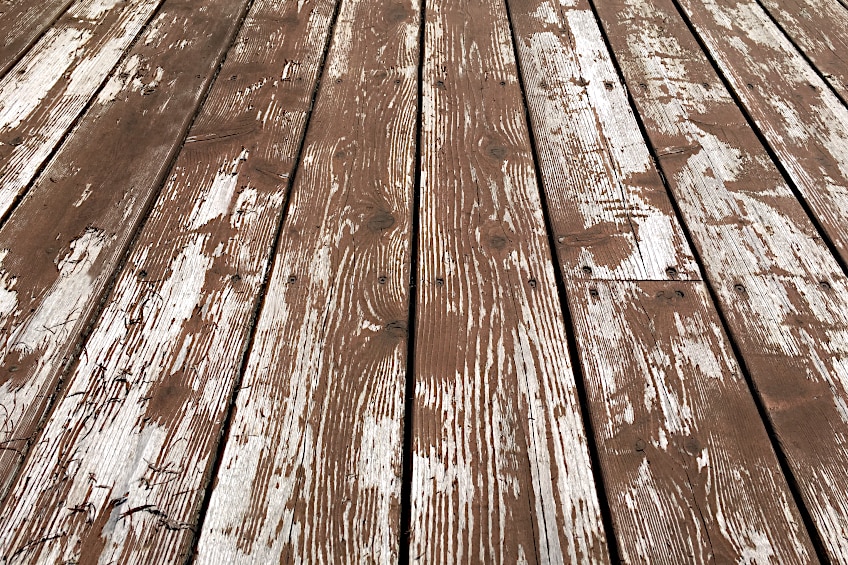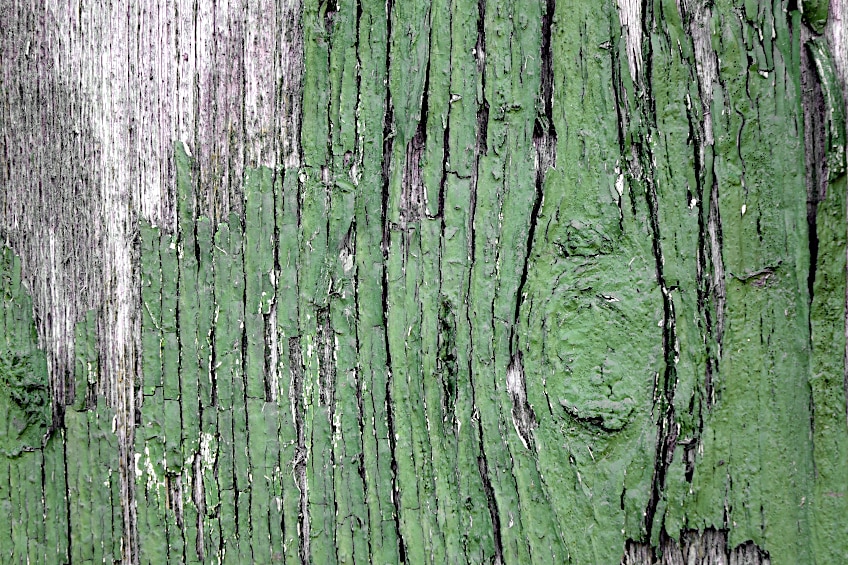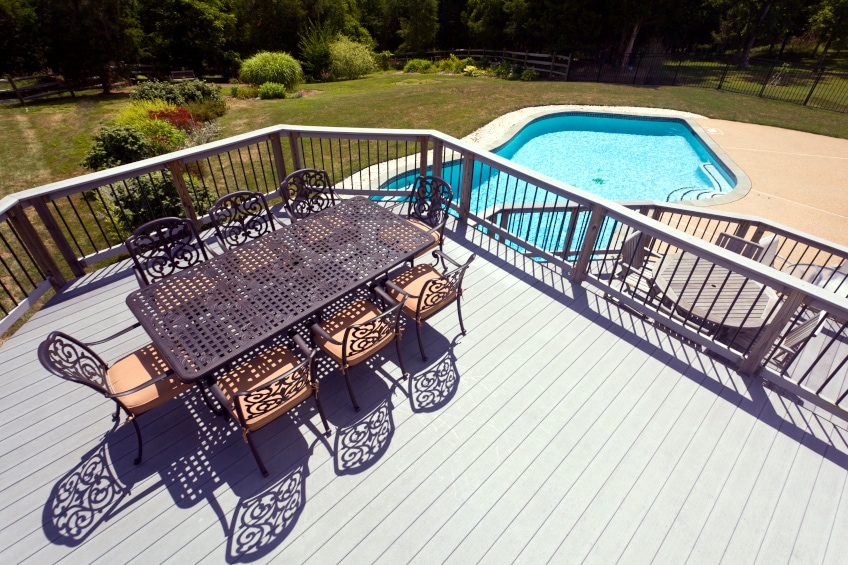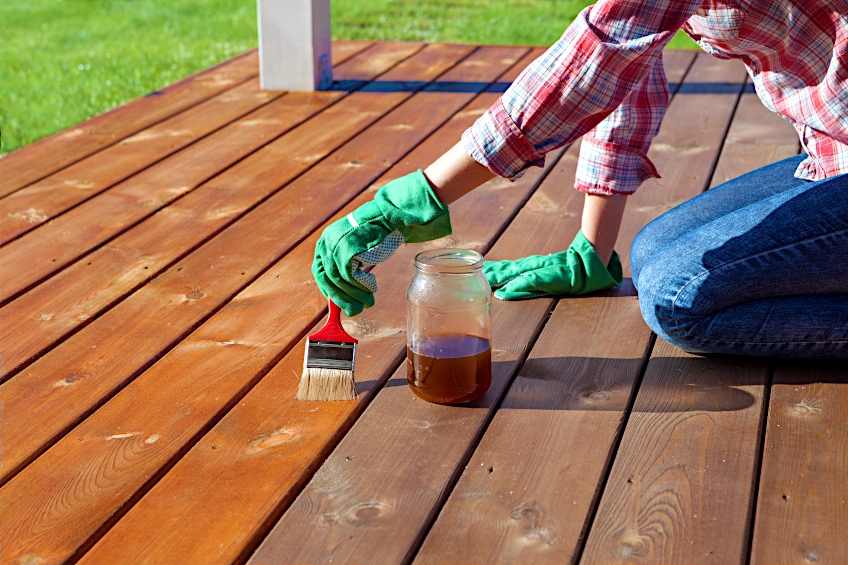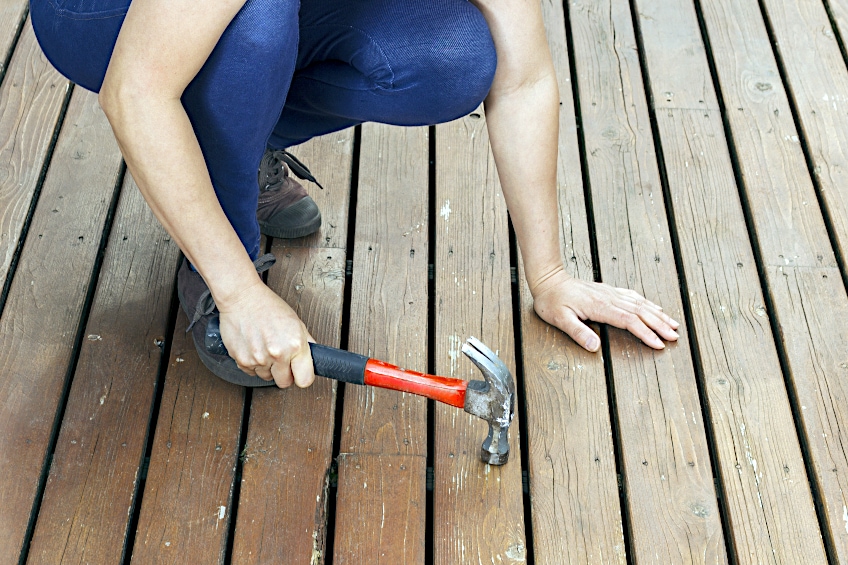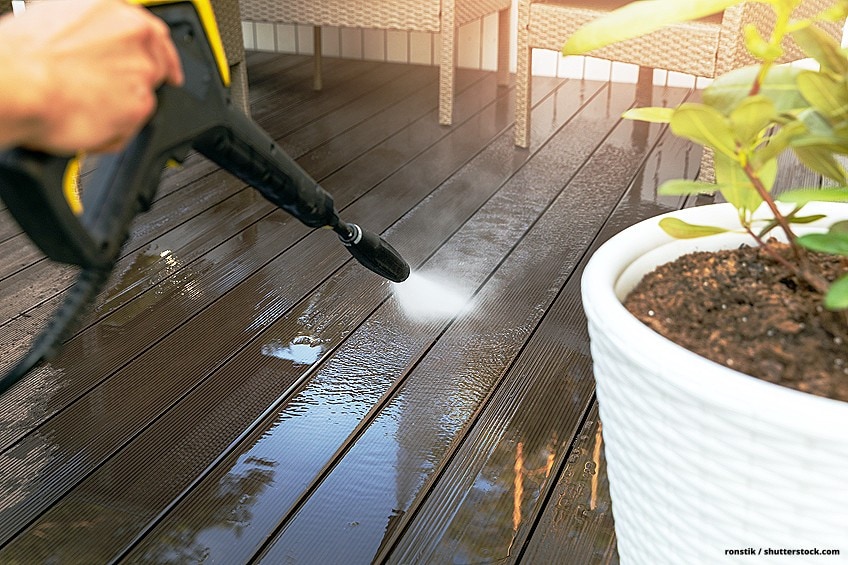Deck Paint vs. Stain – How to Choose a Finish for Exterior Wood
This post may contain affiliate links. We may earn a small commission from purchases made through them, at no additional cost to you. You help to support resin-expert.com
There are few things that really add to both the value and overall aesthetic of a home these days, but exterior decks tend to do just this. After all, what’s not to like? Spending lazy Sunday afternoons out on them with your family or enjoying some late-night stargazing on those late summer nights next to a crackling fire. Decks are awesome is what we’re saying, and if you have one you probably know that they can be pretty challenging to maintain at times. After all, they’re exposed to the elements all the time and they’re basically prime real estate for insects and mold if not adequately protected. This being said, you have two basic options for protecting your wooden decks which are deck paint or wood stain, but which of these options is better? Let’s have a look at both of these substances and discuss which one is best suited for protecting your outdoor deck.
Table of Contents
Deck Paint vs. Stain
The deck paint vs. stain argument is one that many contractors and passionate DIY enthusiasts have been having since decks were first used. Truth be told, they both have their respective advantages and disadvantages, and it really comes down to what you’re willing to put up with in terms of maintenance. To give you a good idea of what these protective substances are, we’ve prepared a short summary of each below detailing what they are and how they work.
Painting Your Exterior Deck
Choosing whether to paint or stain deck wood can be a tough decision, but if you do decide to paint your deck you can rest assured knowing that your wood is well protected and will stay that way until the paint needs to be reapplied. Paint has been argued to take away from the natural aesthetic of exposed wood grain, which is a deal-breaker for those who like the look of natural wood.
On the other hand, if you’re not a fan of visible wood grain then painting your exterior deck might just be what you’re looking for in an aesthetic upgrade. Paint also ensures that the overall visual impact of your deck is uniform, with no wood grain or blotchy planks around to distract the eye. It also means that you can choose a color for your deck that isn’t available through wood treatment and/or natural wood colors.
Keep in mind that paint is considered a surface coating, which means that even though it protects the surface of your deck it will not penetrate as deeply into the wood grain as wood treatment products do. This means that if your paint is damaged or worn over time, your deck will become vulnerable to external forces.
This means that even though you won’t have to repaint your deck for quite a long time after you initially coat it, you will have to re-apply it every few years as the layers degrade over time. The re-surfacing process usually takes place about once a decade if your deck has been painted by a professional, but this does not account for especially harsh weather or excessive foot traffic on your deck.
However, if you aren’t by the means to replace your old deck boards quite yet, or simply don’t want to for sentimental reasons, then paint might be your best option. Why? Paint hides imperfections in the shape and grain of the wood, which means any warping or unsightly knots will be neatly hidden under the paint’s uniform texture and color palette.
As we mentioned previously, choosing whether to paint or stain deck wood is a tough one because there are a few pros and cons to each, but one con that seems to put those knowledgeable about wood off is the fact that paint traps moisture in the wood. This means that the wood will expand and contract as it would when part of a tree, which could ultimately cause your paint to stretch and crack.
- Easy to maintain
- Does not require regular maintenance
- Freedom to choose the color of your deck
- Hides flaws in your deck
- Protects surface from moisture, insects, and heat
- A thick coating between the surface and immediate environment
- Does not penetrate deep into the wood grain
- Traps moisture in the wood fibers
- Obscures the grain of the wood
- Hard to remove if you change your mind
- Has the potential to crack and peel over time
Staining Your Exterior Deck
The painting a deck vs. staining argument has been going on since decks were invented and will probably still be had long after we’re gone. Why? The painting a deck vs. staining argument is a valid one. After all, while paint brings you more color options and adds a nice thick layer of protection to the surface of your deck, wood stain penetrates deep into the wood fibers to provide unrivaled protection for both internally and externally.
What are the pros and cons of staining your deck? Unlike painting your deck, staining is not classified as a surface coating. Wood stain is usually seen more like a wood treatment as instead of simply creating a protective layer on the surface of the wood board it seeps deep into the wood’s fibers and binds with them to not only protect the wood but enhance its color too.
At the end of the day, you still get protection and an aesthetic upgrade for your deck wood with the only difference being the way in which the product interacts with the wood. Many people choose wood stain as opposed to paint because it allows for the grain of the wood to be displayed while still providing protection and an enhanced appearance.
You might also choose wood stain over paint because you want to maintain the natural rustic color scheme that wood provides to any space naturally. The presence of paint in certain settings can be quite jarring aesthetically, and since wood stain gives you the choice between transparent, water-based, and oil-based you have the option of choosing the intensity of your wood color.
Is it better to paint or stain a deck then? Well, this depends on what you want from your deck and the amount of effort you’re willing to put into the maintenance of the surface. Wood stain doesn’t last nearly as long as a good paint job does, so you’re going to pay for the aesthetic appeal of the visible wood grain. However, if you have little ones and are worried about them slipping on the deck, wood stain is better than paint as it provides far more surface friction.
Wood stain also does not work well on slightly grained wood species, and because it isn’t a surface coating it does not fill cracks or imperfections in the wood’s surface. In fact, it highlights them, which means you’ll have to correct these flaws before applying your stain. Well, is it better to paint or stain a deck? Well, it really depends on what you’re willing to put up with and how you’d like to spend your hard-earned money, so this makes it a primarily subjective choice based on your needs and preferences.
- Provides both internal and external protection
- Bonds with internal wood fibers
- Enhances the natural color of wood
- You can choose between solid, semi-transparent, or clear wood stain
- Highlights the wood’s natural grain texture
- Does not last as long as paint coatings do
- Does not hide imperfections
- Will not fill small cracks
- Some wood species do not accept stain very well
- May emphasize imperfections in the wood’s surface
Painting vs. Staining Deck Wood: Which Is More Durable?
Painting vs. staining deck wood, which is the more durable option? Regardless of which aesthetic appearance you prefer, the end goal here is to ensure that you have a deck that lasts. After all, you’d hate to put in all of that work only to find that you need to have your deck resurfaced when the seasons change. So, which one is better then?
Wood Stain
Let’s have a look at the wood stain first. Wood stain is prized for its ability to ensure that your wood’s grain is protected both internally and externally. This in addition to the fact that wood stain highlights and improves the wood’s natural appeal makes it a crowd favorite among those that prefer seeing the wood grain of their exterior decks.
This being said, if your goal is to spend as little time as possible maintaining your deck especially when springtime rolls around after a harsh winter, wood stain is a bad choice. Why? Wood stain needs to be monitored constantly and refinished every two to three years depending on the wood species your deck is made of and the type of stain you’ve chosen to use.
Oil-based wood stain is the best option for staining exterior workpieces as it is inherently water-resistant and assists in protecting your wood from splitting and cracking while exposed to direct sunlight for prolonged periods of time (which your deck will be). Water-based wood stain isn’t a good idea when treating wood that will be situated outdoors as it isn’t as durable or as water repellent.
However, this doesn’t mean that wood stain is a bad choice. When it comes down to it, the choice you make will depend on how much you really want to enjoy the look of your wood’s grain and how much time and effort you’re willing to devote toward maintaining it. If you have a busy lifestyle or aren’t by the means to have a professional come in and maintain your deck for you, we don’t recommend this method of deck protection.
This being said, considering all the pros and cons of staining a deck, the decision is nearly entirely subjective. If you still aren’t sure which to choose, consider asking a question online or at your local hardware store as they’ll have a good idea which wood protection method is best for your local weather conditions, and which will fit your budget.
Wood Paint
Now, let’s have a look at wood paint for the surface of your deck. Paint is a go-top option for those that enjoy more colorful aesthetics and prefer the grain of their decks not to be exposed. There are many reasons for this such as potential splinters, or simply the fact that exposed wood grain would clash with the overall look they’re going for. Either way, paint solves these problems in a quick and effective manner.
How long does deck paint last, then? Well, unlike wood stain deck paint actually lasts for a really long time and does not need to be maintained as regularly as a wood stain does. Therefore, if you’re looking to spend less time maintaining your deck and don’t mind sacrificing the option of showing off the wood grain of your deck, this is the option for you.
Painting your exterior deck with wood stain creates a coating that will last you roughly 10 years depending on the quality of the paint, the initial condition of the wood your deck is made of, and how harsh the temperature changes in your immediate environment are. However, choosing to paint your deck will come with some noticeable drawbacks as we mentioned previously.
Besides hiding the grain of your deck wood, deck painting has been frowned upon in recent years because it traps moisture inside the grain of the wood. This trapped moisture then expands and contracts according to the temperature of your immediate environment, and because the paint is an inflexible medium, it can cause your paint job to crack and tear.
So, how long does deck paint last? Well, up to 10 years depending on where you stay, the type of wood you’ve chosen to paint, and of course the amount of foot traffic the deck will be handling. Also, keep in mind that should you choose to paint your deck; it will be slippery when wet so be sure to remember this if you have little ones running around during the snowy season.
Painted vs. Stained Deck: Which Is More Expensive?
A deck isn’t exactly a basic necessity so you should know that owning one isn’t cheap either. Sure, you get to enjoy it as much as you want but you’re also tasked with maintaining and fixing it if something goes wrong. This being said you’re probably going to want to keep your cost to a minimum, so when it comes to the painted vs. stained deck argument, which is cheaper?
Let’s have a look at the paint first. If you’re going to be painting your deck, you’re going to have to use an exterior boil or acrylic paint. These paints aren’t cheap, especially when they’re being purchased in large volumes. How much can you expect to pay? Well, you can pay up to $35,00 per gallon for the premium stuff, and as low as $25,00 for the more affordable brands.
Wood stain on the other hand is a bit easier on the pocket because it isn’t as expensive to manufacture. This means that you can often get a lot more wood stain than paint if you’re on a budget, which means you’ll likely have quite a bit leftover. This is great because if any areas of your workpiece need to be touched up, you’ll have some stain on hand.
Paint lasts a bit longer than stain, but it’s more expensive and is more challenging to apply. Wood stain on the other hand is cheaper and easier to apply but does not last as long. Choosing which constraints you’re willing to put up with is ultimately the deciding factor when it comes to these mediums, just be sure to take all variables into account when making your decision.
How to Apply Wood Deck Paint and Wood Stain
Now that you know what wood stain and paints are as well as which one is more durable, it’s a good idea to know how to apply these substances if you intend on taking on the challenge yourself. This being said, let’s have a look at how to effectively apply both wood stain and paint to your wooden deck.
How to Apply Wood Stain
Wood stain is really easy to apply and won’t take you very long either. All that you need to do is ensure that your surface is prepared correctly before applying your wood stain to the deck and you’re pretty much good to go. How do you prepare your surface? First, ensure that all nail heads are flush with the surface of the board and that any dents and/or holes have been properly filled in.
Once all your holes have been filled and your deck has been cleaned it’s time for you to get your wood stain ready. Although stain can be applied with a brush, we recommend applying it with a roller to ensure even distribution. Be sure to give your wood stain a good stir before pouring some out into a paint tray.
Once poured, pop your roller in there and get it nice wet with your wood stain. Using your roller, apply your wood stain following the length of each board or by covering one section of the deck at a time. This way you can ensure that you get consistent coverage over your entire deck with no blotchy spots around the edges. Once you’re satisfied with the job you’ve done applying your stain, allow it to dry for the manufacturer’s recommended time period.
How to Apply Deck Paint
Painting anything can be quite an undertaking if you don’t have any experience, but it can be especially challenging when you have to paint a large flat surface like a wooden deck. As when working with any wooden workpiece, it’s important to clean it thoroughly with some soapy water and allow it to dry completely before moving on to the next step in the process.
Once your workpiece has been cleaned, it’s time for you to sand and prime the surface. Using an orbital sander, lightly sand the surface of your workpiece and remove any debris either with a brush or with the help of some compressed air. Once your surface is clear, mix up your primer, pour some out into a paint tray, get some on your roller, and prime your deck by following the length of each board.
Allow the primer to dry and cure for the manufacturer’s recommended time period before moving on to the next step in the process. Once the primer has dried it’s time to get to painting. As you did with your primer, mix it up well and pour some into a painting tray.
Once you’ve had enough, get some on a fine nap roller and paint your deck following the length of each board. You should need roughly two to three coats of paint to create a lasting covering for your deck. Be sure to allow each coat to dry completely before applying the next.
Now that you know the difference between wood stain and deck paint, which one is easier to apply, which option is cheapest, which one is the most durable, and how to apply each one correctly, it’s time for you to get out there and put your new-found knowledge to the test. Remember to consider your local weather conditions as well as how each substance will interact with the wood species your deck is made of when making your choice.
Frequently Asked Questions
Can You Paint a Deck?
Can you paint a deck? Yes, it is possible to paint a wooden deck and it’s actually one of the more durable solutions to decorating your exterior deck. Oil-based paints and acrylic-based paints are some of the best options for exterior decks as they repel water well seep and deep into the wood’s fibers.
Does Wood Deck Paint Last?
Does wood deck paint last? Wood deck paint is typically oil-based which means that it is quite durable. This paint type which can be specially formulated for outdoor applications can actually last for a little over 10 years, which means you won’t have to worry too much about maintenance, splitting, or cracking.
How Long Do Wood Decks Last?
Wood decks tend to last for a relatively long time. The average wooden deck has a life-span of around 10 to 15 years, but this does depend on the type of wood that your deck has been made out of. Denser, heavier wood species that have been correctly treated have the potential to last even longer than this.


